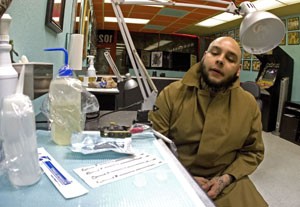PHOENIX – Did you know it’s legal in Arizona for someone to puncture your skin with a needle for profit without a license?
One lawmaker wants to change that by adding any body art establishment to the list of places that need to be licensed by the Pima County Health Department.
Starting in 2010, any body art establishment, which includes tattoo and piercing parlors, would have to be licensed by the local health department and would be subject to certain regulations, just like restaurants or public bathrooms, according to SB 1321.
The legislation might have come about because of the increasing popularity of body art, said Patti Woodcock, a spokeswoman for the Pima County Health Department.
“”I don’t think the health concerns were such that it was perceived to be a business that needed to be regulated by any agency,”” she said.
A whole new set of fees and training would also have to be provided to the department for the staff to know what proper procedures are in a tattoo or piercing shop, she said.
With body art’s increasing popularity, Dick Goldman, owner of Blue Dragon Tattoo in Glendale, lobbied Rep. Meg Burton Cahill, D-Tempe, to introduce legislation.
“”There are a lot of tattoo shops opening up unbelievably quickly,”” he said.
Many shop owners might not be aware of cross-contamination or diseases that can be passed through needles, said Goldman, who has been in the industry for 29 years.
“”We’ve needed legislation for a long time,”” he said.
About one-third of Americans between the ages of 18 and 25 have gotten tattoos, according to a January 2007 study published by the Pew Research Center.
Jay Cavna, owner of Sanctity Tattoo, 970 E. University Blvd., said when he and his wife, Kim, relocated to Arizona from New York, they were surprised by the lack of regulations on tattoo parlors.
“”It definitely should be regulated,”” Kim said.
Isaiah Camacho, owner of Staring Without Caring, 1024 E. Sixth St., said state regulation might wean off tattoo shops that are open just for profit, and be beneficial to the more legitimate and high-quality shops around town.
Camacho, who has been tattooing for five years, said the only downfall he could see with the legislation is if the health department didn’t communicate effectively with shop owners.
“”If it’s just outsiders, you could have something crippling the industry and they could set some precedent wrongly,”” he said.
Deciding where to get a tattoo is largely a common-sense practice, students said yesterday.
Picking a tattoo parlor is not a decision that should be made on a whim, said Jeremy Laufer, an undeclared freshman.
“”You shouldn’t just walk up to some random shop,”” Laufer said. “”You’ve got to do some research.””
Some basic research that can be done to ensure a safe and clean tattoo experience includes checking to see if the artist has a license, said Nicholas Mayer, an undeclared freshman.
If not, that should be a red flag, Mayer said.
Perhaps the easiest way to ensure safety is to take advantage of word-of-mouth references about specific shops and artists, said Stacey Parven, an education freshman.
Before getting her tattoo, Parven did extensive research on the trade and spoke with friends who had tattoos, she said.
“”There are some places that probably aren’t clean,”” Parven said. “”It’s important to talk with people so that you don’t get an infection.””
When it comes to safety, the decision goes beyond clean equipment, said Kiel Siler, a music theory sophomore.
Besides looking at the condition of the equipment and competency of the artist, Siler said he also paid close attention to the price.
“”There are basic rules you have to go by,”” he said. “”A cheap tattoo isn’t good, and a good tattoo isn’t cheap.””
– Shain Bergan contributed to this story.









